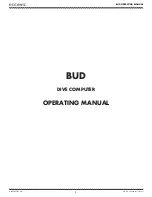
Using Watt's Up
19
1.
Use a transient voltage suppression (TVS) zener diode across meter's leads.
Add an
appropriate unidirectional transient voltage suppressor (TVS) zener diode like a "Transorb"
with the "cathode" side on the meter's plus (red) lead and the other end on the negative
<black) lead. The TVS cathode end usually has a band. Make sure the TVS turn on voltage
is above that of the voltage being measured, but it's clamp voltage is below that of the
meter's max rating. A higher Joule/power/energy rating is better, other things being equal.
As an example, the Diodes Inc. partnumber: 1.5KE43A (which Digi-Key carries) is a
unidirectional ~ 43 Volt turn on, 1500 Watt TVS Zener diode with axial leads that clamps
voltages to less than 60V. It would not be appropriate in circuits having measured voltages
near or greater than 43 Volts because it would start shorting them out at ~ 43 Volts.
This approach does not affect meter accuracy, but does limit the maximum applied voltage
to somewhat less than the TVS diode's turn on voltage.
2.
Use auxiliary power and add series resistor to measured voltage.
Power the meter
using the Auxiliary Connector connected to a voltage source that exceeds by one volt the
voltage to be measured by the meter. E.g 13V to the auxiliary connector if measuring a
12V power source. Connect the voltage to be measured to the plus lead of the meter via a
non wirewound (they're inductive) resistor with a value of at least 270 Ohms and power
rating of ¼ Watt or more. A 274 Ohm resistor adds ~ -0.1% error (will read low) to voltage
(not current) measurements. Higher resistance increases protection, but at increased voltage
error. E.g. a 1.3K Ohm which increases voltage error to ~ -0.5%. Digi-Key carries the
inexpensive Yageo, MFR series metal film resistors (e.g. pn: MFR-25FBF-274R) which
will work as will many others. The Auxiliary power source must be free of voltage
transients itself. It can be connected through a resistor as well as long as the IR voltage
drop from the ~7 mA meter operating current results in voltage at the meter that still
exceeds the voltage being measured. E.g. a 270 Ohm resistor would require a minimum 15
Volt source due to the (270 X 0.007) 1.9 V drop across the resistor.
Failure to provide sufficiently high Auxiliary voltage will result in the meter being
powered by the measured voltage. Any added resistor will then add an IR voltage drop
error to measured readings. E.g. ~1.9V using a 274 Ohm resistor.
3.
Remove internal power sharing diode.
***
This is an Absolutely unsupported
modification – don't even think of getting support for this or making a warranty
claim on a meter whose case has been opened ***.
With the case open, carefully remove
diode D1. Once done, this will require powering the meter through the Auxiliary
Connector, but will also make the meter more robust against overvoltage transients and
remove the requirement that, to be the sole power source, the Auxiliary Connector voltage
must exceed the measured SOURCE voltage.
The following diagram shows components added to increase transient voltage protection as
well as the use of a pushbutton switch to reset meter readings.
"Watt's Up" & "Doc Wattson" Watt Meter and Power Analyzer User's Manual
RC Electronics, Inc.
L o a d s
P o w e r S o u r c e s
L e g e n d
P l u g c o n n e c t o r
S o c k e t c o n n e c t o r
M e a s u r e d
P o w e r
S o u r c e
L o a d
+
-
" T h r e e W i r e " H o o k u p s h o w i n g
t r a n s i e n t p r o t e c t i o n c o m p o n e n t s a n d
r e s e t s w i t c h c o n n e c t i o n
m e t e r
+
-
S
O
U
R
C
E
L
O
A
D
X
M a k e n o
c o n n e c t i o n
A u x i l i a r y
P o w e r
S o u r c e
+
-
O p t i o n a l ,
n o r m a l l y o p e n ,
s i n g l e p o l e ,
p u s h b u t t o n
s w i t c h t o r e s e t
m e t e r r e a d i n g s
T V S
P r o t e c t i o n
R e s i s t o r
+
-
+
-
c a t h o d e e n d
N e g a t i v e L e a d
C u r r e n t F l o w
© c o p y r i g h t 2 0 0 4 - 2 0 0 7 R C E l e c t r o n i c s , I n c . A l l r i g h t s r e s e r v e d















































